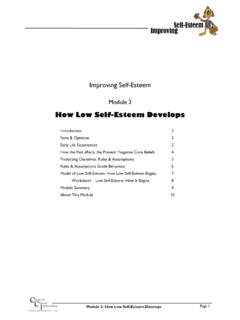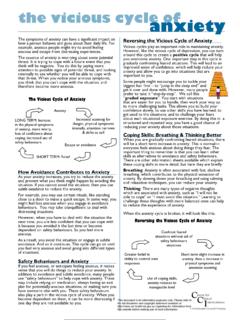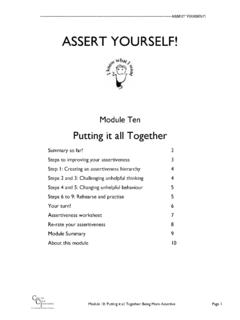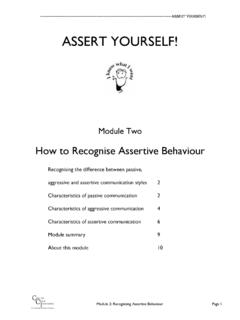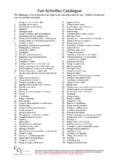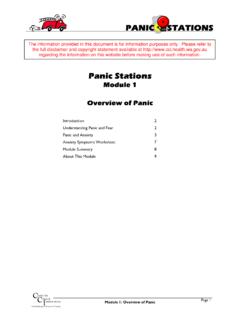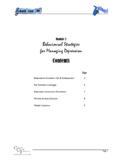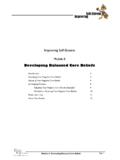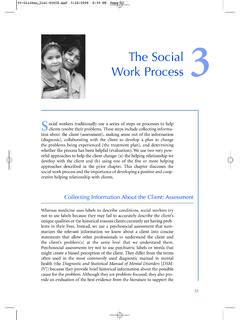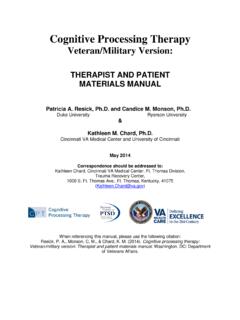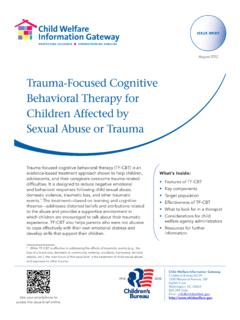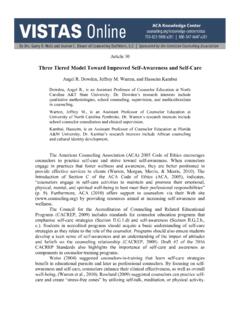Transcription of CBT for Psychotic Symptoms Therapist Manual
1 Cognitive Behavioural Therapyfor Psychotic Symptoms :A Therapist s ManualLaura Smith, Paula Nathan, Uta Juniper, PatrickKingsep & Louella LimPublished by: Centre for Clinical Interventions: Psychotherapy, Research and TrainingCognitive Behavioural Therapy for Psychotic Symptoms2 Centre for Clinical Interventions, 2003 This Manual is available from the:Centre for Clinical Interventions: Psychotherapy, Research & Training223 James WA 6003 ISBN 1 - 876763 - 23-xSuggested citation:Smith, L., Nathan, P., Juniper, U., Kingsep, P., & Lim, L. (2003) Cognitive Behavioural Therapy forPsychotic Symptoms : A Therapist s Manual . Perth, Australia: Centre for Clinical Behavioural Therapy for Psychotic Symptoms3 ContentsPagePreface5 IntroductionRationale for treatmentCCI treatment manualKey treatment componentsAssessing treatment outcome7 Treatment ModulesUsing the ManualModule 1: Early Treatment AssessmentModule 2: Symptoms Specific AssessmentModule 3: Early Treatment EngagementModule 4: Psycho-educationModule 5: Cognitive Therapy for DelusionsModule 6: Cognitive Therapy for VoicesModule 7: Behavioural Skills TrainingModule 8: Cognitive Therapy for Secondary SymptomsModule 9: Self Management PlanningModule: 10: Post Treatment Assessment1719233343536373839599107 References113 Cognitive Behavioural Therapy for Psychotic Symptoms4 Appendix 1: HandoutsWhat Is Psychosis?
2 Stress Vulnerability ModelEarly Warning SignsCalming Technique: Breathing & RelaxationThinking & FeelingThe Feelings CatalogueDetective Work115117120123125128130131 Appendix 2: WorksheetsExpectations QuestionnaireGoals of TherapyFire Drill for CopingThe Change Process Balance SheetStress-Vulnerability WorksheetEarly Warning Signs WorksheetWeekly Activity ScheduleMy Thought DiaryExperiment RecordProblem SolvingStep LadderSelf-Management Plan133135136137138139140141142143144146 147 Cognitive Behavioural Therapy for Psychotic Symptoms5 PrefaceA substantial body of evidence now documents the significant prevalence of psychoticdisorders mental health problems in the Australian community. The recent NationalSurvey of Mental Health and Wellbeing reported that 4 to 7 people per 1000 of theAustralian adult population have a Psychotic disorder.
3 This statistic translates to morethan 100,000 Australian adults and clearly indicates that that there are a significantnumber of people who are struggling with the severely debilitating Symptoms andexperiences associated with psychosis. Unfortunately people with psychosis in oursociety also carry a significant burden of distress, disability and social dysfunction andthere is an identified lack of community based rehabilitation programmes that could helpaddress these issues (Jablensky, et al 1999).The extent and complexity of mental health and psychosocial problems, places enormouspressure on treatment facilities to provide appropriate and effective interventions. Thistreatment protocol helps address this need. It was developed by the Centre for ClinicalInterventions (CCI), which provides specialist clinical treatments, training and clinicallyapplied research programs.
4 CCI was established to provide a scientific environmentwithin which evidence supported clinical practice and the theoretical understanding ofpsychopathology are investigated, with the aim of decreasing patient distress andincreasing patient empowerment. The establishment of CCI has allowed clinical practice,training and research to be mutually interactive and treatment protocol is the application of evidence based psychological practice toPsychotic Disorders. The Manual has been written by clinicians for clinicians and presentsa clinical guide based on empirical foundations and clinical treatment protocol provides the Therapist with a comprehensive, detailed andsystematic approach to treatment delivery. The Manual is divided into modules, whichdescribe the treatment components of this individual therapy.
5 Importantly, the manualdoes more than describe the content of what to do , but also describes the process bywhich each treatment component is delivered. Details about evaluation procedures arealso included, as are activities and handouts for clients, self-monitoring diaries andmaterials to be used by the would like to express our gratitude to the Office of Mental Health of the Department ofHealth for their support of the quality improvement work carried out at would especially like to express our respect and gratitude to the clients who have socourageously participated in our interventions and thus travelled with us along the path toscientific this Manual provides a comprehensive guide to mental health practitioners, keycompetencies are required, and it is highly recommended that in order to apply theprotocol most effectively appropriate training and supervision is R Nathan (Director)
6 Cognitive Behavioural Therapy for Psychotic Symptoms6 Cognitive Behavioural Therapy for Psychotic Symptoms7 IntroductionRationale for TreatmentSince the 1950s, the usual first-line treatment for persons with chronic psychoticdisorders has been neuroleptic medication. The effectiveness of this type of treatmenthas brought about important improvements in the care and management of individualssuffering these disorders. Despite the significant advances made, there is a growingawareness that medication alone is not a sufficient treatment for Psychotic illness in , many patients continue to experience persistent and distressing psychoticsymptoms despite appropriate doses of medication. In the recent National Survey ofMental Health and Wellbeing report, People Living with Psychotic Illness , 61% ofparticipants reported that they had experienced either delusions and/or hallucinationswithin the last month (Jablensky et al.)
7 , 1999) - Symptoms , which are typically highlydistressing. This was despite the finding that the majority of those participants weretaking prescribed medication for their mental health problems (86%) and most (83%)reported that their Psychotic Symptoms responded to this medication (Jablensky et al.,1999). In addition, of male participants, and of female participants reportedexperiencing a continuous course of illness with no remission of Symptoms (Jablensky etal., 1999). In other words Psychotic Symptoms tend to persist or to re-occur over thelong term for a majority of patients with Psychotic , psychosis is associated with an increased risk of associated emotionaldisturbance. This is reflected in the prevalence of comorbid depression and anxiety inthis group of patients and the elevated risk of suicide found in people with schizophrenia(and other Psychotic illnesses) in comparison to the general , there is a significant degree of social disability associated with having a psychoticillness that is not (and can not) be addressed by use of medication alone.
8 This includesthe disability associated with persistent Symptoms and associated emotional disturbance,but also reflects problems with social isolation, and difficulties in finding suitableaccommodation and work. In the Australian setting a recent large-scale study of peopleliving with a Psychotic illness identified a serious lack of lack of .. psychosocialtreatment and management modalities (Jablensky et al., 1999, ).Cognitive Behavioural Treatments for Psychotic DisordersOver recent years, psychosocial approaches to managing psychosis have shifted from apurely behavioural focus to an emphasis on the interaction of cognitions and behaviourthe Symptoms of psychosis. There has been a particular emphasis on the factorsmaintaining the experience of residual Psychotic Symptoms ( hallucinations), but alsoon the distress and disturbance that can be associated with experiencing these Behavioural Therapy for Psychotic Symptoms8 Persistent Psychotic symptomsThe London-East Anglia group in the UK carried out one of the largest and best-designedstudies investigating the effectiveness of CBT for medication resistant Symptoms .
9 Theyinvestigated a manualised, individual treatment for medication resistant psychoticsymptoms (including hallucinations and delusional beliefs). Their treatment containedcognitive and behavioural treatment was first piloted with 13 patients (Garety, Kuipers, Fowler, Chamberlain, &Dunn, 1994). This small trial indicated that the treatment was helpful in reducing patients conviction in their delusional beliefs. On the basis of these initial, positive results, thetreatment trial was expanded to become a full randomised controlled trial - with a largernumber of patients who were followed up over a longer period of time. The results ofthis larger trial were published in a series of papers highlighting different aspects ofoutcome and follow CBT group showed significant improvements over the course of treatment on ameasure of Psychotic symptomatology.
10 The magnitude of the change in psychoticsymptomatology was similar to that found in clozapine treatment trials with the samepopulation of patients (Kuipers et al., 1997) - without the possible side effects associatedwith use of this medication. Additional analyses showed that 21% of the CBT groupachieved a large clinical improvement and a further 29% of the showed a reliable clinicalimprovement (Kuipers et al., 1997) on the same positive outcomes in this study could not be explained by medication in fact, overthe course of the trial, more control subjects had their medication increased, and nonehad their medication decreased, while two of the treatment subjects had reducedmedication (Kuipers et al., 1997). This is a particularly important finding given that manypatients identify significant impairment associated with medication side effects (Jablenskyet al.)
